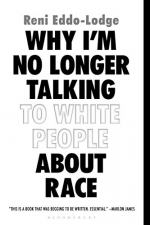|
This section contains 562 words (approx. 2 pages at 400 words per page) |

|
Why Im No Longer Talking to White People About Race Summary & Study Guide Description
Why Im No Longer Talking to White People About Race Summary & Study Guide includes comprehensive information and analysis to help you understand the book. This study guide contains the following sections:
This detailed literature summary also contains Topics for Discussion on Why Im No Longer Talking to White People About Race by Reni Eddo-Lodge.
The following version of this book was used to create this study guide: Eddo-Lodge, Reni. Why I’m No Longer Talking to White People About Race. London: Bloomsbury Publishing, 2017.
This nonfiction work serves to shine a light on the racial injustices in Great Britain and the conversations surrounding racism and anti-racism. The work begins with a detailed recollection of Britain’s history, specifically focusing on slavery, legislation and World Wars. The author, Reni Eddo-Lodge, explains how Britain's education system does a poor job of accurately conveying the past, or at the very least, fails to mention some very important information.
The next chapter explains what systemic racism is and to what extent it exists in Great Britain. The author provides many examples and statistics to support the argument she presents. Most of the examples in this chapter revolve around education, healthcare, workforce and police brutality. She explains how racism is present in all of Great Britain's establishments, despite any obvious acts of racism. Racism prevails because Great Britain was created to serve wealthy white men. Anyone else may face racism, sexism, classism, or any other type of prejudice. This is further explained in the next chapter, titled “What is White Privilege?”. Eddo-Lodge defines white privilege as a lack of opportunity and protection for Black people; things that white people take for granted. White people are protected by the laws of the country, while Black people are targeted by them. White privilege does not suggest that white people are always successful or have not faced hardships, it means that their skin color has not caused such hardships. This privilege also includes white people being able to turn on the television and see people that look like them. White people hold the most powerful positions in the world, which can be very discouraging for Black kids growing up. Black people need to work twice as hard to guarantee a proper education, a job, healthcare, and even safety from police. Racism extends far beyond just obvious violence or racial slurs.
In Chapter 4, titled “Fear of a Black Planet,” it is explained how white privilege allows this irrational fear of Black people “taking over.” The interview with Nick Griffin is an important part of the chapter as it demonstrates how illogical it is to fear that white people will become the minority or at least that should be the rational conclusion when one learns that 81% of the population is white. This fear is rather easy to debunk since the racism demonstrated easily exposes itself.
Chapters 5 and 6 address larger topics to introduce the term intersectionality as connections are made to systemic racism. Chapter 5 tackles feminism while Chapter 6 addresses class. Eddo-Lodge explains how race plays a part in both of these topics. Feminism must acknowledge that Black women and other minorities face challenges that are different than those of white women. When addressing class, she explains how a Black person’s class is often determined or limited by their skin color. Most importantly, she wants readers to be aware of how intertwined cultural issues can be. For example, it would be a disservice to discuss feminism without discussing race. The final chapter of the novel simply reminds readers that racism is alive and well. It is a powerful force that has been overlooked for far too long and the responsibility falls on everyone to be anti-racist.
Read more from the Study Guide
|
This section contains 562 words (approx. 2 pages at 400 words per page) |

|



